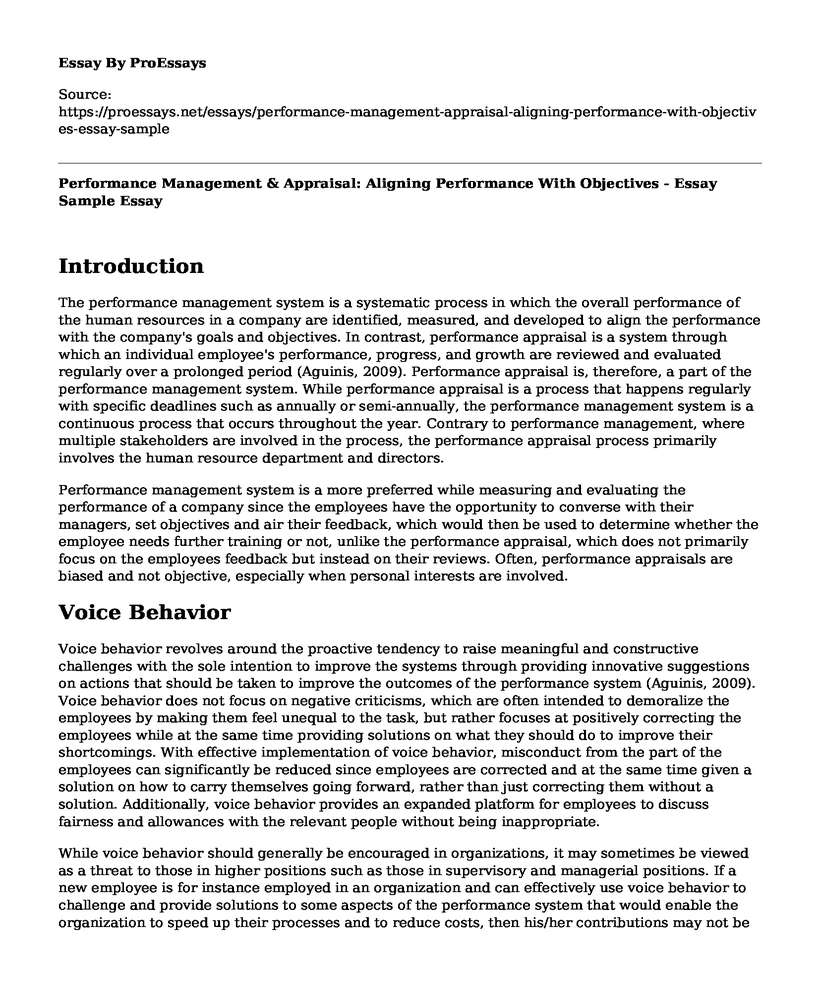Introduction
The performance management system is a systematic process in which the overall performance of the human resources in a company are identified, measured, and developed to align the performance with the company's goals and objectives. In contrast, performance appraisal is a system through which an individual employee's performance, progress, and growth are reviewed and evaluated regularly over a prolonged period (Aguinis, 2009). Performance appraisal is, therefore, a part of the performance management system. While performance appraisal is a process that happens regularly with specific deadlines such as annually or semi-annually, the performance management system is a continuous process that occurs throughout the year. Contrary to performance management, where multiple stakeholders are involved in the process, the performance appraisal process primarily involves the human resource department and directors.
Performance management system is a more preferred while measuring and evaluating the performance of a company since the employees have the opportunity to converse with their managers, set objectives and air their feedback, which would then be used to determine whether the employee needs further training or not, unlike the performance appraisal, which does not primarily focus on the employees feedback but instead on their reviews. Often, performance appraisals are biased and not objective, especially when personal interests are involved.
Voice Behavior
Voice behavior revolves around the proactive tendency to raise meaningful and constructive challenges with the sole intention to improve the systems through providing innovative suggestions on actions that should be taken to improve the outcomes of the performance system (Aguinis, 2009). Voice behavior does not focus on negative criticisms, which are often intended to demoralize the employees by making them feel unequal to the task, but rather focuses at positively correcting the employees while at the same time providing solutions on what they should do to improve their shortcomings. With effective implementation of voice behavior, misconduct from the part of the employees can significantly be reduced since employees are corrected and at the same time given a solution on how to carry themselves going forward, rather than just correcting them without a solution. Additionally, voice behavior provides an expanded platform for employees to discuss fairness and allowances with the relevant people without being inappropriate.
While voice behavior should generally be encouraged in organizations, it may sometimes be viewed as a threat to those in higher positions such as those in supervisory and managerial positions. If a new employee is for instance employed in an organization and can effectively use voice behavior to challenge and provide solutions to some aspects of the performance system that would enable the organization to speed up their processes and to reduce costs, then his/her contributions may not be taken kindly by the supervisors or the mangers, who might perceive his proactive voice behavior as a threat to their positions. Thus, voice behavior can be utilized in a performance management system to assess whether the organization has the best people in leadership positions. Leaders who are more receptive to voice behavior are more preferred in an organization since they can take the challenges and recommendations raised by their juniors to the advantage of the organization, rather than leaders who are ridged to accept challenges and suggestions from their juniors.
Tangible Returns and Relational returns
Tangible returns are the total compensation received by the employees in the form of money and benefits such as allowances, among others. In contrast, relational returns are the impalpable benefits received by the employees in the form of recognition and awards, opportunities such as learning and security in employment, among other benefits (Aguinis, 2009). While most of the returns, either tangible or relational, are directly related to the performance of the individual employees, some are related to positions of leadership and seniority and not the performance.
References
Aguinis, H. (2009). Performance management. Upper Saddle River, NJ: Pearson/Prentice Hall. Retrieved from file:///C:/Users/user/Downloads/Performance-Management-3rd-Edition-by-Herman-Aguinis%20(1).pdf.
Cite this page
Performance Management & Appraisal: Aligning Performance With Objectives - Essay Sample. (2023, Mar 28). Retrieved from https://proessays.net/essays/performance-management-appraisal-aligning-performance-with-objectives-essay-sample
If you are the original author of this essay and no longer wish to have it published on the ProEssays website, please click below to request its removal:
- Pros and Cons of Leadership Models and Grids Essay
- Paper Example on Enterprise Implementation Challenge: Technical Issues
- Globalism Vs. Globalization Essay Example
- Essay Example on HIWP: Addressing Human Resource Managers' Concerns
- Paper Example on 3 TAA Strategies: Static, Reactive & Anticipatory
- Paper Example on KraveBeauty Skincare: Cleansing Less for Better Skin Health
- Leadership Philosophy and Attributes - Paper Example







